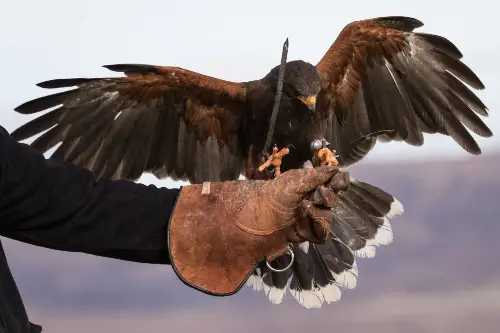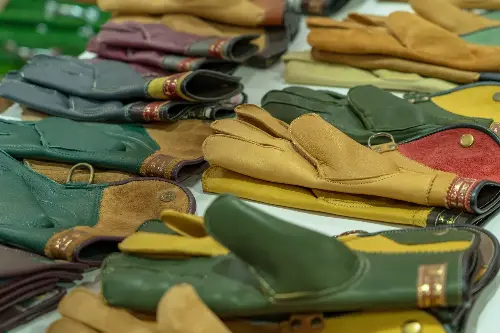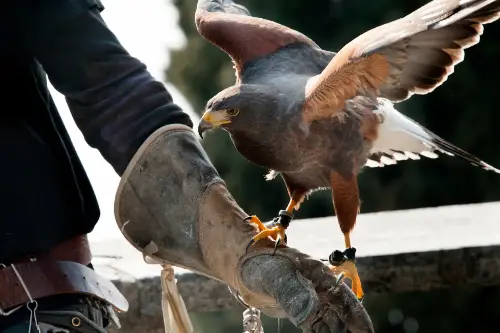Falconry, the ancient art of training birds of prey to hunt, has been practised for thousands of years, capturing the imaginations of people across the globe. Throughout its storied history, the safety of both the falconer and the bird of prey has remained paramount. Amidst an array of tools and techniques developed for this majestic sport, falconry gloves hold a special place. These specialised gloves are more than just protective gear; they are an essential part of falconry that enhances the intimate interaction between the falconer and their avian companion.

The Craftsmanship of Falconry Gloves
The design of falconry gloves is a homage to traditional craftsmanship blended with modern understanding of avian anatomy and human ergonomics. Crafted from high-quality leather, these gloves are typically made from cowhide, deerskin or elk skin – materials that provide the optimal balance of softness and strength. The importance of choosing the right leather cannot be understated; it must be supple enough to allow for dexterity but robust enough to withstand the powerful grip of a raptor's talons.
The construction of a falconry glove is a precise art. The glove's thickness varies across its surface to protect the falconer from the sharp talons while not sacrificing mobility and tactile sensation. A double layer of leather, or even Kevlar in some cases, reinforces the high-stress areas such as the fingertips and the gauntlet, which extends up the forearm, providing additional protection against errant nips and scratches from the bird of prey.
The Significance of Glove Fit and Comfort
A well-fitting glove ensures that a falconer can handle their bird with confidence. Gloves that are too tight could restrict blood flow, while those that are too loose risk the bird's safety if the glove slips off. Therefore, custom-fit gloves are not uncommon in the falconry community. A perfectly fitted glove provides the falconer with the best control over their bird, enabling smoother training sessions and more effective hunts.
Apart from the fit, comfort is also a notable factor. Falconers often spend hours with their birds, either during training or while out in the field. The glove not only needs to allow for easy rotation of the wrist but also adequate ventilation to prevent the falconer's hand from sweating, which could lead to the glove degrading prematurely.

Protection Meets Functionality
While the primary purpose of falconry gloves is to protect the handler from the bird’s talons, their functionality extends further. The gloves facilitate the bird's understanding of where to land and perch, serving as a designated safe spot for the raptor. The bird learns to associate the glove with positive reinforcement, such as receiving food, reinforcing the bond between bird and human.
Additionally, the glove acts as a buffer between the falconer's movements and the bird's claws, preventing the bird from feeling insecure or unstable while perched. This stability is critical during the early stages of training when the bird is acclimatizing to being handled by a human.

The Art of Communication Through the Glove
The nuanced interaction between falconer and bird often goes beyond verbal commands and relies heavily on the non-verbal cues given through the glove. Experienced falconers use the glove's pressure and movement to communicate with their birds, directing them with slight movements of the hand and wrist. These subtle signals help in creating a language that the bird learns to comprehend and respond to, further enhancing the falconer’s control during flight and recall.
Gloves as a Symbol in Falconry Culture
Beyond their utilitarian purpose, falconry gloves carry deep symbolic meaning within the falconry community. They signify the trust and respect between the falconer and the bird. By donning the glove, the falconer is accepting the responsibility of caring for a wild raptor, respecting its power and wild nature.
To the outside observer, these gloves may appear to be merely part of the falconer's attire, but to those within the sport, they represent a badge of honour. The wear and tear on a glove often tell the story of many successful hunts and the deep bond formed over countless hours spent with the bird.
In conclusion, falconry gloves are a testament to the unity of form, function, and craftsmanship in the sport of falconry. They embody the intricate relationship between human and bird, a connection founded upon mutual trust and respect. As falconry continues to thrive and evolve with the modern era, the glove will remain an enduring symbol of the falconer’s art, protecting and enhancing the age-old bond between humankind and the majestic birds of prey that grace the skies.
